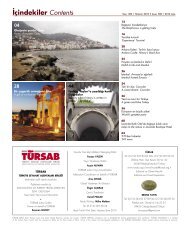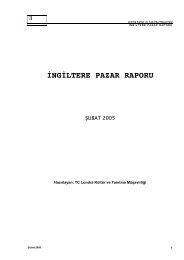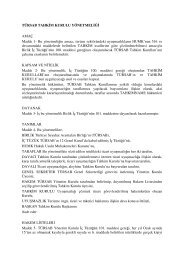Amasya - Türkiye Seyahat Acentaları Birliği
Amasya - Türkiye Seyahat Acentaları Birliği
Amasya - Türkiye Seyahat Acentaları Birliği
- No tags were found...
Create successful ePaper yourself
Turn your PDF publications into a flip-book with our unique Google optimized e-Paper software.
Ganj nehrinde yıkanan Hintlikadınlar (Shutter stock/ PalTeravagimov (solda), 1900’lüyıllardan banyo fotoğrafı(altta), Efes Yamaç Evler’dekiRoma hamamı (sağ sayfasol altta), Yamaç Evler’deduvardan geçen su boruları(sağda) ve Roma’daki Caracallabanyolarının 1908 yılındaçizilmiş ilüstrasyonu (sağalttta).Indian Women washing in theRiver Ganja (Shutter stock/ PalTeravagimov (left), A Bath Photofrom 1900s (bottom), RomaBath in Ephesus Yamaç Evler(on the right page, bottom left),Water pipes going through wallsin Yamaç Evler (right) and anillustration of Caracalla baths inRome, which was drawn in 1908(bottom right).Kayıtlara göre, Roma’daki ilk hamam, MÖ25 yılında İmparator Augustus’un damadıAgrippa tarafından yaptırılmıştı. Büyük havuzuile hamam ya da banyodan çok kaplıcayıandırıyordu. Ama öyle büyük bir beğenitoplamıştı ki, peşpeşe, daha küçük ve hamamabenzer modelleri yapıldı. MS 4. yüzyılagelindiğinde Roma’da 11 büyük ve muhteşemgenel hamam binası, 1350’den fazla çeşme veyüzlerce özel hamam bulunuyordu.Avrupa 1000 yıl banyosuz yaşadıRoma’nın hamam tutkusu, Hristiyanlıklabirlikte hor görülmeye başlandı. Hattagünah sayıldı. İlk Hristiyan rahipleri vücuttemizliğini; lüks, dünyevi zevklere düşkünlük,paganizm olarak görüyordu. Bu yüzdenbirkaç yüzyıl boyunca Yunan ve Romalılarıntemizlik anlayışları unutuldu. Ortaçağ boyuncaAvrupa, bugün sıklıkla söylendiği gibi 1000yıl banyosuz yaşadı.Buna karşın İslam Dünyası temizliğin “farz”olduğu bir inanışa sahipti. Doğal olarakhamamlar gündelik yaşamın en anlamlıduraklarından biriydi. Ayrıca hamamlarındoğurganlığı artırdığınainanılıyordu. Yavaş yavaşkadınlar için özelhamamlar ya dahamamlarda özelgünler görülmeyebaşlamıştı.Haçlı Seferlerisırasında Hristiyanlar,Müslümanlarınhamamlarınıgördü. Onlarla vetemizlik anlayışı ile“yeniden” tanıştı. Ülkelerine54 TÜRSAB DERGİ | AĞUSTOS 2013always under the heavy influence of religion, cultureand technology. As some unassertive communitieswere making the point of washing, mighty andostentatious societies were avoiding it. For example,Polynesians were cleaner than researchers coming totheir island. The history of washing in the Ganja River(for purifying spirits rather than cleaning) was mucholder than the most ancient European civilization.In fact, to speak about a trustworthy finding or a“first” on a topic such as washing or bathing isnot possible. How would we know who were thefirst people to have washed in rivers or lakes?Nonetheless, archaeological researches are able toapproximate a date. For instance, it turned out to bethat the bath has 5 thousand years of history in thesoils where the Gaza Strip lies now. In the Babylonexcavations, argil bowls dating back to 2800 BCand containing a soap-like matter wereunearthed.Meeting Place in RomeThe first known bathtubsbelong to the Minoancivilization in Crete.These tubs made forMinos, the legendaryking in the 1700s BCwere within the splendidKnossos Palace and almost hadthe same size as modern ones. The mostimpressive side of the story is the plumbingsystem connected to these royal tubs. Terracotta(earthenware) pipe drains that weredesigned to provide pressure to the water (topush the water outward) were connected to eachother with a cement-like matter.The right of taking a bath was not grantedexclusively to nobles in Rome. There wereplaces where all people -except slaves- couldmeet, wash, and talk about politics or art, oreven eat. They looked like our modern baths.According to the recordings, the first bath inRome was built by Agrippa, the groom of EmperorAugustus, in 25 BC. Rather than a bath, it resembledthermal springs with its big pool. It received so muchattention that it inspired the smaller and more bathlikemodels that were built later. By 4 th century AD,Rome hosted 11 huge magnificent bath buildings,more than 1350 springs and hundreds of privatepools.Europe lived without bathsfor a thousand yearsRome’s passion for bathing waseventually disdained along withChristianity and was evendeemed to be a sin. EarlyChristian priests consideredbody cleaning as a luxury,paganism, and an addictionto worldly pleasures. Thus,for several centuries, thebathing practices ofthe Greek and Romanpeople were forgotten.In medieval times, asit’s often stated today,Europe lived withoutbaths for 1000 years. Onthe contrary, the Muslimworld has a creed which
















